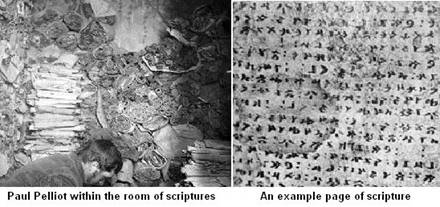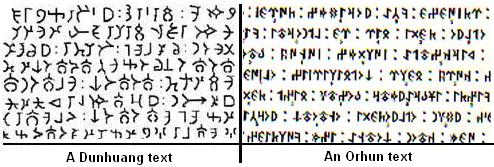|
Paul
Pelliot (1878 1945) was a French Sinologist who traveled to
the Inner Asian side of China during the early years of 1900.
His expedition started from Kucha where he found documents
written in the Kushan language (see Chapter 35,
Kushan Empire). After
Kucha, Pelliot went to Urumqi (Urumchi), the present capital
of the Uighur Autonomous region. He finally reached Dunhuang
on the 12 of February 1908. The north-western part of China
shown on the map below is the Uighur Autonomous Region,
written as Xinjiang but pronounced as Sincan. The ancient city
of Dunhuang, Dunghuang or Tung-Han shown below-right stands on
the west of Kara-Khoto and is within Sincan.

The
name of Dunhuang is made out of Tung and Han, where Tung is,
most probably, a twisted form of Tur-ung meaning belonging to
the Tur and Han is found in Chinese as Huang (see Chapter 5,
Climatic Changes).
There is also an ethnic group in north-western Asia known as
the Tunguz. The Chinese call these people the Dong Hu. The
transformation from Tunguz to Dong Hu strengthens the regular
relation between Tung-Han
and Dunhuang.
In
Dunhuang, Pelliot convinced the abbot Wang Yuanlu to let him
examine a room full of ancient manuscripts. The room contained
some 50,000 rolls written in a language which was unknown to
the Chinese. The abbot, who wanted to renovate the monastery
sold 6,000 of these rolls to Pelliot who carried them to
France. Presently these manuscripts can be found in 29
different museums of the world. Below we see Paul Pelliot
examining some manuscript in the room where the rolls were
stored on the left and a portion of an original manuscript on
the right.

The
characters of these manuscripts are almost identical to the
Orhun syllabary mentioned in Chapter 21,
The
Orhun Script.
Below we see a short text transcribed from an original
manuscript known as Irk Bitig
on the left and a portion of the Bilge Kagan stele on the
right. Not only do the letters match each other, but also the
words are separated by two superimposed dots in both scripts,
pointing to a common style of writing
(1).
We can therefore conclude that the manuscripts were written by
a Turkic speaking culture

Irk
Bitig is a small book whose dimensions are 13X8 cm. It
contains 104 pages and 65 paragraphs. The book is a narrative
of the epics of Asiatic people and also contains portions of
fables and soothsaying. It is presently exhibited in the
British Museum.
The above
portion of the book is telling about a gathering, celebrating
the leadership of Ata-Utuk.
Such celebrations were always followed by a round of mare
drink known as Kimiz. Each person drank a sip from the same
container specially designed for such occasions (see Chapter
15, The Sacred horn)
and promised solidarity to their leader.
Drinking in
ancient times, when written documents were not so widespread
as today, was a way of sealing a promise. It meant: I
internalize and unite with these words agreeing to never break
my promise. We find many statues in Central Asia of a person
holding a drinking vessel. Similar statues and relief have
been found in remote places, wherever these people migrated.
Several such examples will be discussed in the next chapter. |